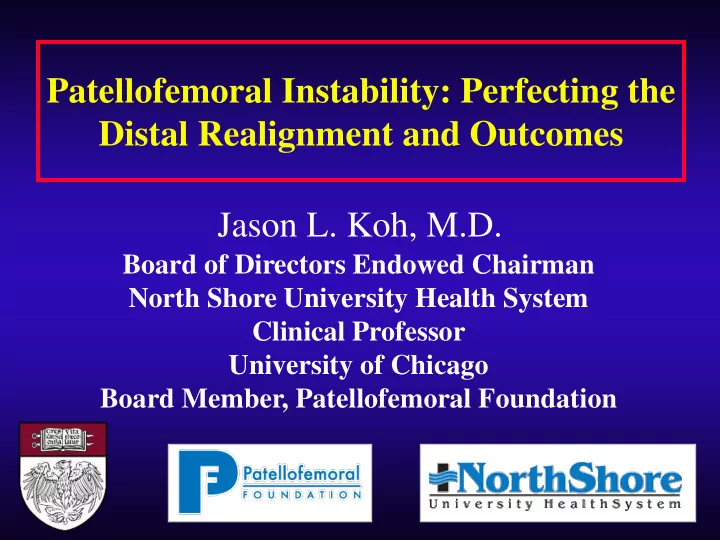

Patellofemoral Instability: Perfecting the Distal Realignment and Outcomes Jason L. Koh, M.D. Board of Directors Endowed Chairman North Shore University Health System Clinical Professor University of Chicago Board Member, Patellofemoral Foundation
Thoughts • Bone trumps soft tissue • Significant bony malalignment = bony procedure • Repairs of weak tissue are…weak • Primary repair increased failures with dysplasia • Fixing pathoanatomy may require several parts
Who needs a tibial tubercle osteotomy? • Instability – patients with significant bony abnormality / alta • Unloading chondral lesions • Can be combined with cartilage procedures
Anterior Tibial tubercle – Trochlear groove (ATT-TG) Distance • Objective, reliable • > 15 mm abnormal • > 20 mm “Objective patella instability (OPI)” • I would consider distal realignment • Can be done w/MRI • (Dejour)
Patella height • ALL RATIOS 1:1 + 0.2 • Blackburn-Peel (most reliable) A:Y • Caton A:X • Insall-Salvati B:Z • Consider distalization if >1.4
Tubercle realignment for instability • No need for significant anteriorization • Relatively flat shingle • Consider distalization by up to 1 cm if necessary (usually not) • Goal is about 1.2:1 ratio
Patella alta – goal 1.2
Unloading procedures (tibial tubercle) • Fulkerson oblique osteotomy • Anterior – medialization of tubercle • Very reliable for appropriate lesion
Biomechanics of Fulkerson osteotomy • Anteriorize – shifts load proximal • Medialize – shift load medial
Results (Pidoriano and Fulkerson) • results depending on location of defect • distal , lateral facet of patella or lateral trochlea • NOT for CENTRAL, DIFFUSE, or PROXIMAL
Technique: Workup • MRI if lesion appropriate • Distal, lateral patella; lateral trochlea
Assess articular cartilage arthroscopically • Evaluate for other articular cartilage lesions
Lateral cartilage lesion
Skin incision centered on tubercle • For smaller degrees of correction, can use shorter shingle (5cm) • For significant anteriorization, consider longer shingle (7cm)
Define medial and lateral borders of tubercle and patella tendon • Open anterolateral fascia and elevate musculature • Avoid going deep to septum • Note small perforators at proximal edge • Determine obliquity of shingle • Taper shingle to distal tip, leave 2-3 mm distally unless distalizing • Osteotomy angled medial to lateral and proximal to distal • use small oscillating saw (ACL type saw) and irrigate • Soft tissue protected with retractors
Oscillating saw
Finish proximal portion with curved osteotomes
Osteotomes
Note oblique osteotomy
Osteotomy anteromedially translated • Measure distance translated • Provisionally fixed with k wire
Measurement
Assess patellofemoral tracking arthroscopically to see if lesion is unloaded
Scope
Fix tubercle with lag technique • I use 2 4.0 headless variable pitch screws or 3.5 screws • Can use 4.5 screw – but will have to remove many • Knee is flexed to 90 degrees and posterior neurovascular tissues allowed to fall away
Fixation
Stabilize shingle
Assess tubercle radiographically in AP
And lateral; grab posterior cortex with screw
Closure and Rehab • Leave fascia open • Allow ROM • Patella mobilization • Progress to full weightbearing at 6 – 8 wks • Early WB runs a risk of later stress fracture of the tibia at proximal osteotomy site (Fulkerson, SCOI experience) • CPT code distal realignment 27418
Caveats • Avoid over medialization • Watch patella tracking after provisional fixation • I try for slight lateral initial touch of patella • Neurovascular structures are close posteriorly (Kline et al) • Avoid early weightbearing (Fulkerson, Stetson) • Risk of nonunion of tuberosity relatively small
Results • Allow progression of activity • Typically will take 4-6 months for sport • Extensor lag may persist for 6-8 months • May have progression of patellofemoral arthritis requiring further surgery; however, in most cases, results are durable • Combined results with cartilage procedures may be better
Results • Roux-Goldthwaite: 14% redislocation, 25% arthritis (Sillanpaa CORR 2008) • AMZ: 31 patients, 4.4 yrs: 1 redislocation, 1 tip fx, 2 hardware removal (Ding Injury 2015) • Fulkerson 93% good-excellent at 5 years • Jim Bradley – AJSM 2010 – 41 Fulkersons in 34 athletes – avg age 20; mean fu 46 months • 97% return to sport w/o recurrence
Complications • Nonunion – may have delayed union • Preservation of tip attachment may decrease • Shingle fracture – 1 case reported by Cosgarea • Proximal tibia fracture – associated with early WB (SCOI, Fulkerson) • (I had one associated with a fall down the stairs)
Overmedialization
Tubercle realignment: TTTG >20 mm or patella alta ratio >1.4 • Avoid over medialization • Goal distalize 1.2; medialize to TTTG 10-15 mm
Over distalization
Revision
Thank you!
Recommend
More recommend